산업기술








무기 거래 조약(ATT)은 최근 몇 달 동안 국제적으로 많은 관심을 받고 있는 논쟁의 여지가 있는 주제입니다. 2014년 12월 24일 무기거래규제에 관한 첫 번째 협정인 무기거래조약(Arms Trade Treaty) 발효 세계의 많은 지역에서.
갱단 전쟁, 조직 범죄, 조직 범죄, 범죄 조직 전쟁과 같은 분쟁에서 소형 무기와 경량 무기가 점점 더 널리 퍼지고 있기 때문에 그러한 무기의 불법 거래에 대한 적절한 통제는 정치와 인권 모두에 상당한 영향을 미칩니다. 내전, 테러. 그러한 무기의 불법 거래에 대한 통제를 강화하려는 욕구가 증가함에 따라 무기를 효과적으로 추적하고 추적해야 할 필요성도 증가합니다. 무기 거래 조약은 2001년 유엔 행동 계획(PoA) 및 2005년 국제 추적 도구(ITI)를 기반으로 하는 더 강력한 무기 통제의 필요성에 대한 수십 년 간의 논쟁의 절정입니다.
기본적으로 무기 거래 조약은 다음을 요구합니다. 정부는 전 세계의 인권을 침해하는 데 사용될 수 있는 불법 거래 및/또는 무기 판매를 줄이기 위해 모든 무기 판매를 보고해야 합니다. 웹에서 ATT와 관련하여 많은 논의가 진행되면서 ATT와 관련된 사상가 및 업계 간행물의 50가지 통찰력을 모았습니다. 이러한 발췌문, 인용문 및 통찰력은 무기 거래 조약의 이행, ATT의 필요성에 대한 설득력 있는 사례, 물류, 데이터 관리 및 무기 추적 영향, ATT가 수정헌법 제2조 권리에 미치는 영향을 둘러싼 우려를 포함합니다.
목차:
무기 거래 조약 정보
무기 거래 조약은 2013년 4월 2일 유엔에서 채택되었습니다. 현재 50개 이상의 국가가 이 조약을 비준했으므로 2014년 12월 24일부터 발효됩니다. 다음 인용문과 발췌문이 더 자세한 내용을 제공합니다. 무기 거래 조약의 목적에 대해.
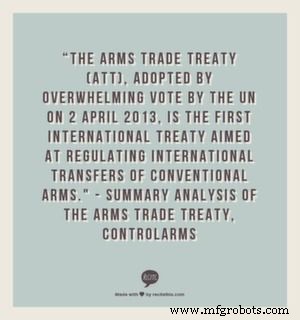
1. “2013년 4월 2일 UN에서 압도적인 표차로 채택된 무기 거래 조약(ATT)은 재래식 무기의 국제적 이전을 규제하는 것을 목표로 하는 최초의 국제 조약입니다. 조약은 불완전하지만 재래식 무기 거래를 통제하기 위한 국제적 행동의 중요한 기반을 마련합니다. 그것은 국가의 관행이 다른 국가와 국제 시민 사회에 의해 측정될 새로운 글로벌 규범을 만듭니다.” – 무기 거래 조약 요약 분석 , ControlArms, Twitter:@controlarms
2. "이 조약은 국가가 무기 금수 조치를 위반하는 재래식 무기 또는 대량 학살, 인도에 반한 범죄, 전쟁 범죄 또는 테러에 사용되는 무기를 수출하는 것을 금지합니다.
"또한 국가가 재래식 무기가 무기에 도달하는 것을 방지해야 합니다. 암시장." – Barbara Plett, UN이 역사적인 무기 거래 조약을 압도적 다수로 통과 , BBC 뉴스, 트위터 @BBCBarbaraPlett
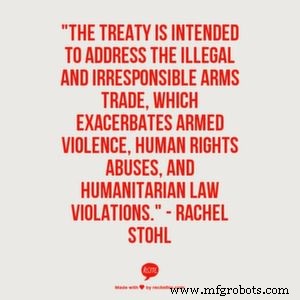
3. “ATT는 정부가 국제 무기 수출 결정을 내릴 때 적용해야 하는 특정 기준을 설정합니다. 이 조약은 무장 폭력, 인권 침해 및 인도법 위반을 악화시키는 불법적이고 무책임한 무기 거래를 해결하기 위한 것입니다. 이 조약은 전 세계 무기 거래에 특정 표준을 적용하고 정부가 국제 무기 거래의 여러 측면, 특히 수입, 수출, 운송/환적 및 중개를 다루기 위해 이러한 표준을 국내 법률 및 규정에 통합할 것을 요구합니다. 이 조약은 무기가 합법 시장에서 불법 시장으로 전환되는 것을 방지하고 재래식 무기의 확산이 전 세계 인구에 미치는 파괴적인 영향을 완화하는 데 도움이 되도록 이러한 기준을 설정합니다.” – Rachel Stohl, 무기 거래 조약이 중대한 이정표에 도달 , Stimson, Twitter @rachelstohl
4. “'산업'은 다양하고 큰 커뮤니티입니다. 책임감 있는 기업은 글로벌 산업을 규제하기 위한 글로벌 규범의 필요성을 매우 잘 알고 있습니다. 정부 및 시민 사회 파트너와 협력하여 일하는 것은 독특하고 성공적인 경험이었습니다.” – Andrew Wood, Rolls Royce의 전략적 수출 통제 이사, 50 50 축하
5. 토마스 컨트리맨(Thomas Countryman) 미 국무부 국제안보 및 비확산담당 차관보는 지난 10일(현지시간) 스팀슨 센터에서 열린 공개 포럼에서 “조약은 협상의 원래 동기였던 인도주의적 목표에 기여하는 데 있어 시간이 지남에 따라 차이를 만들 것”이라고 말했다. 4월 5일 워싱턴에서. '세계 최악의 사람들, 아프리카와 다른 곳에서 분쟁을 부추기는 사람들에게 무기 공급을 줄이는 데 차이를 만들 것입니다.'
“조약은 ' 이 조약의 미국 수석 협상가인 컨트리맨은 "수입국과 수출국의 이익을 보호한다"고 말했다. 그는 '가장 중요한 것은 '이동 국가'뿐만 아니라 해당 국가에 의무를 부과한다는 것입니다.”라고 말했습니다.” – Thomas Countryman, 미국 국무부 국제 안보 및 비확산 차관보, Arms에서 인용 Control Today, 특별 보고서:유엔 총회, 압도적인 투표로 무기 거래 조약 채택 , 무기 통제 협회, Twitter @jeffabramson
무기 거래 조약이 필요한 이유
무기 거래 조약은 인권 침해에 사용될 가능성이 있는 무기의 불법 거래를 줄이기 위한 노력의 일환으로 무기의 수입과 수출에 대한 일관된 틀을 제공하는 것을 목표로 합니다. 폭력은 세계 여러 곳에서 점점 더 흔해지고 있습니다. 무기 거래 조약은 분쟁 지역에서 일반적으로 사용되는 무기에 대한 접근을 제한하는 중요한 첫 단계입니다.
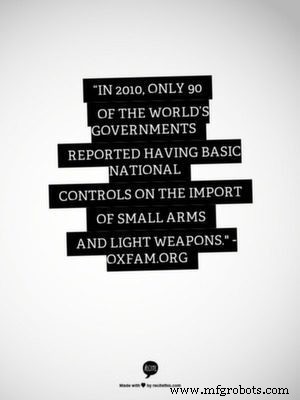
6. “2010년에 세계 정부 중 90개만이 소형 무기 및 경무기 수입에 대한 기본적인 국가 통제를 갖고 있다고 보고했습니다.
“국제 무기 거래에 법적 공백이 있는 이유는 무엇입니까?
“세계는 무기 거래에 대한 일련의 국제 규칙을 갖는 데 동의한 적이 없습니다. 이것이 믿기지 않을지 모르지만, 우리는 바나나와 MP3 플레이어 판매에 관한 가장 복잡한 규칙을 가지고 있지만 무기 거래에 대한 견고하고 국제적으로 구속력 있는 규칙은 없습니다.” – Oxfam.org, Twitter @Oxfam
7. “보통 법 집행 기관과 형사 사법 시스템 기록을 기반으로 하는 전국 살인 사건 수를 비교하는 것은 문제가 있습니다. 과소보고; 정의의 국가 법률 시스템 간의 차이점; 기록 방식의 차이로 인해 국가 간 범죄 데이터를 비교하는 것이 불가능한 경우가 많습니다.” – 필수 등록 데이터를 사용한 살인 사건 추적 , Small Arms 설문조사 뉴스, Twitter:@SmallArmsSurvey
8. “재래식 무기는 수단, 소말리아, 시리아, 멕시코, 콜롬비아, 이라크, 이란, 카슈미르, 버마, 다르푸르, 콩고 공화국 및 기타 국가 및 지역과 같은 세계 분쟁 지역의 무장 전투원에게 판매됩니다. 이러한 무기는 종종 인권 침해와 잔학 행위를 저지르는 데 사용됩니다. 여성과 어린이는 종종 이러한 학대의 피해자입니다. 무제한 무기 밀매로 인한 지속적인 무장 전투는 전체 지역을 불안정하게 만들고 삶의 모든 측면을 방해하며 많은 수의 난민을 발생시킵니다. 옥스팜 인터내셔널(Oxfam International)은 아프리카 대륙이 수입 재래식 무기의 사용으로 인해 연간 경제 활동에서 최소 180억 달러의 손실을 입는 것으로 추산하는데, 이는 아프리카 국가에 대한 모든 국제 개발 원조의 연간 액수를 합한 것보다 더 많은 손실입니다.” – Eileen Harrington, Mary Ann McGivern이 에서 인용 전국 가톨릭 기자 , 사내 Loretto 뉴스레터 Interchange, 트위터:@NCRonline
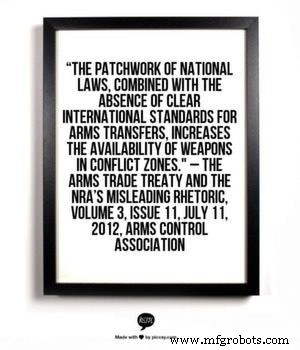
9. “버마, 콩고, 라이베리아, 수단, 시에라리온에서의 최근 전쟁과 같은 시리아에서 진행중인 갈등은 재래식 무기와 탄약의 국제적 이전에 대한 공통 기준과 모든 국가가 다음을 수행해야 하는 법적 구속력이 있는 요구 사항에 대한 긴급한 필요성을 강조합니다. 특히 인권 침해로 이어질 수 있거나 국제 무기 금수 조치를 위반할 수 있는 무기 이전에 대해 수출 및 수입을 검토하십시오.
“미국과 일부 다른 국가에서는 무기 거래에 대해 상대적으로 엄격한 규제를 가지고 있지만 많은 국가에서는 약합니다. 또는 비효율적인 규정이 있는 경우.
“무기 이전에 대한 명확한 국제 표준의 부재와 함께 국내법의 패치워크는 분쟁 지역에서 무기의 가용성을 증가시킵니다. 무책임한 무기 공급자와 중개인은 이러한 조건을 악용하여 미군과 싸우는 사람들을 포함하여 파렴치한 정부, 범죄자, 반군에게 무기를 판매할 수 있습니다.” – 무기 거래 조약과 NRA의 오해의 소지가 있는 수사 , 3권, 11호, 2012년 7월 11일, 무기 통제 협회, Twitter:@armscontrolnow
10. “연간 약 50만 명이 총기로 사망하는 것으로 추산됩니다. 사람들은 전쟁터에서 그리고 국가 탄압과 범죄 조직에 의해 죽임을 당합니다.
“전 세계적으로 수백만 명의 다른 사람들이 전쟁에 갇힌 상태에서 의료, 물 또는 식량에 대한 접근을 거부당하고 있기 때문에 사망합니다. 팔의 흐름이 잘 제어되지 않습니다. 예를 들어, 콩고 민주 공화국에서는 1998년 이후 무력 충돌로 인해 간접적으로 500만 명이 넘는 사람들이 사망한 것으로 추산됩니다.
“무력 충돌과 무력 폭력으로 사망한 모든 사람에 대해 우리는 더 많은 사람들이 부상당하고 고문을 당하고 학대를 받고 강제로 실종되고 인질로 잡혔거나 총을 겨누고 인권을 부정당했습니다.
“문제는 절대적으로 방대하고 현재 진행형입니다. 시리아, 이라크, 리비아, 남수단. 무책임한 무기 거래는 조만간 세계 여러 지역에서 사람들의 삶과 생계의 모든 영역을 파괴할 수 있습니다.” – 브라이언 우드(Brian Wood), 국제앰네스티 무기 전문가, 세계 무기 거래 조약 – 초보자 가이드:50차 비준 업데이트 , Amnesty.org, Twitter @AmnestyOnline
11. “무기 수출에 대한 권한을 가진 모든 관리, 특히 워싱턴, 베이징, 모스크바의 관리들이 내가 경험했던 것처럼 독재자, 전쟁 군주, 살인 마약 군대 및 민병대의 손에 무책임한 탄약이 흘러들어가는 인간적 대가를 경험할 수 있기를 바랍니다. 그것; 가까이서 개인적으로 한 번에 한두 명이 사망했습니다.
“지난주 나이로비에서 일어난 대학살은 시리아 정부나 소말리아에 기반을 둔 알 재래식 무기를 사용하여 잔학 행위를 저지르는 샤밥. 지난 주에 마침내 미국이 서명한 무기 거래 조약(ATT)은 바로 그것을 하도록 설계되었습니다. 미국 서명이 중국과 러시아에 더 많은 정치적 압력을 가하기를 바랍니다.” – Frank Jannuzi, 국제앰네스티 미국 부국장, 킬링필드에서의 여정:마침내 무기 거래 조약, 허핑턴 포스트, 트위터 @FrankJannuzi
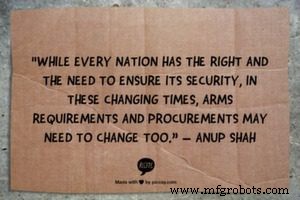
12. “무기 거래는 인권 침해의 주요 원인입니다. 일부 정부는 사회 개발, 통신 인프라 및 건강을 합친 것보다 군사 지출에 더 많은 비용을 지출합니다. 모든 국가는 안보를 보장할 권리와 필요성이 있지만 이러한 변화하는 시대에 무기 요구 사항과 조달도 변화해야 할 수 있습니다.” – Anup Shah, 무기 거래—고통의 주요 원인 , GlobalIssues.org, Twitter:@globalissuesorg
13. 미국은 외국 땅에 무기를 공급하고 있으며, 보고된 바에 따르면 그 중 많은 부분을 잊어버리고 있습니다. “정부 감독 기관은 펜타곤이 아프가니스탄 보안군에 제공한 총기의 40% 이상을 추적하지 못하여 관리들이 신생 군대를 무장시키는 '당근 채찍' 접근 방식을 고려하도록 촉구했다고 말했습니다. 월요일 공개될 예정인 아프가니스탄 재건 특별 감찰관은 아프가니스탄으로 보낸 무기를 추적하는 국방부의 두 가지 기본 정보 시스템인 신뢰할 수 있는 물류 감독 데이터베이스의 운영 검증과 안보 협력 정보 포털에 오류가 많다고 말했습니다.” – Maggie Ybarra, 보고:아프가니스탄으로 보내진 무기의 40%가 행방불명 , 워싱턴 타임즈, 트위터 @WashTimes
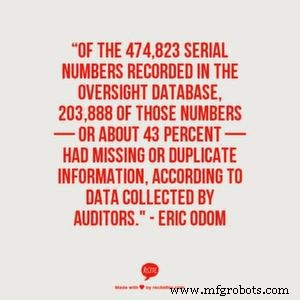
14. Liberty News의 보고서에 따르면, “지난 10년 동안 펜타곤은 보고서에서 설명하는 747,000개 이상의 무기와 보조 장비를 6억 2,600만 달러의 비용으로 아프간 국가 안보군에 제공했습니다. 소총, 권총, 기관총, 유탄 발사기 및 산탄총과 같은 소형 무기가 이러한 무기의 대부분을 차지합니다.
“감독 데이터베이스에 기록된 474,823개의 일련 번호 중 203,888개 또는 약 43% — 감사자가 수집한 데이터에 따르면 정보가 누락되었거나 중복되었습니다. 감사관은 조사 과정에서 데이터베이스에서 24,520개의 일련 번호가 종종 두 번 이상 반복되고 50,304개의 일련 번호에 배송 또는 수령 날짜가 첨부되지 않았음을 발견했습니다.
“통합 보안으로 알려진 다국적 군대 조직 전환 사령부-아프가니스탄은 보안군에 무기를 전달하고 이전하는 것을 감독해야 합니다. 그러나 감사관이 수집한 데이터에 따르면 보안 사령부는 책임 요구 사항에 미치지 못하는 것으로 나타났습니다.
“감사관에게도 똑같이 우려되는 점은 아프가니스탄 보안군이 사용하는 총기 추적 방법이 손으로 쓴 하드카피 문서의 조합을 기반으로 한다는 것입니다. 보고서에 따르면 때때로 시스템에 올바르게 입력되지 않는 레코드 및 Microsoft Excel 스프레드시트가 있습니다." – Eric Odom, ARMING THE ENEMY:펜타곤, 아프가니스탄에서 수십만 개의 무기 분실 사실을 인정 , 리버티 뉴스, 트위터 @ericjodom
15. “현재 유탄 발사기와 AK-47보다 바나나와 iPod의 국제 판매를 규제하는 법률이 더 많습니다. 그 결과 아프가니스탄에서 우리 군대를 죽이는 총알과 아프리카에서 군벌들이 대량 학살을 저지르는 데 사용하는 무기가 이 규제되지 않은 환경에서 번성하는 암시장에서 구매됩니다. 무기 거래 조약은 군벌, 독재자, 테러리스트에 대한 불법 무기와 탄약의 유출을 막을 기회입니다.” – 무기 거래 조약 , American Values Network, Twitter:@AmerValuesNet
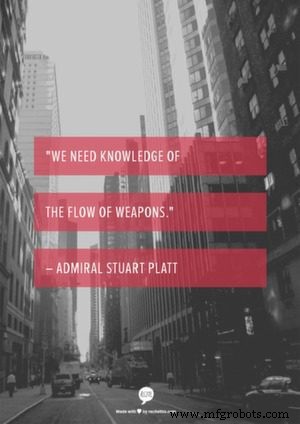
16. 수년 간의 노력을 통해 글로벌 무기 거래에 대한 보다 엄격한 규제의 필요성은 수십 년 동안 명백해졌습니다. 2011년 보도 자료에서 “방산 계약자이자 퇴역 군인이자 퇴역한 미 해군 소장인 Stuart Platt 제독은 무기 거래에 대한 추가 규정에 대해 분명한 지지를 보냈습니다.
“'전투의 본질이 변하고 있습니다. 적 전투원은 그림자 속에 숨어 있기 때문에 제복이 없습니다. 책임 있는 국가로서 민간인을 다치게 하지 않으려는 우리의 바람은 종종 우리 군대가 선제 사격을 하도록 노출시킵니다.
“‘무기, 무기, 치명적인 전투 장비 및 도구의 병참 추적을 따라야 합니다. 지도자들이 사전에 조치를 취할 수 있도록 그들이 어디로 가고 있는지 알아야 합니다. 우리는 무기의 흐름에 대한 지식이 필요합니다.
“'이제 오늘날의 불법 무기 거래상, 총기 소지자, 밀수업자, 테러리스트에게 이 사람들은 악마의 지옥 깊숙한 곳에 삽니다. 무기가 어두운 네트워크에서 자유롭게 흐르면 우리 군대는 예상보다 더 위험에 처합니다.'” – 스튜어트 플랫 제독, Victor Bout의 재판 하이라이트 무기 거래 조약의 필요성 강조 , The American Values Network, Twitter:@AmerValuesNet
17. Victor Bout은 2011년에 무기 거래 조약의 필요성을 둘러싼 많은 논의의 초점이었습니다. 인터뷰에서 전 남아프리카 공화국 의원이자 "The Shadow World:Inside the Global Arms Trade"의 저자인 Andrew Feinstein은 말합니다. , “공식적인 무기 거래와 '그림자 세계' 사이의 경계는 매우 모호합니다. [현재 뉴욕에서 재판을 받고 있는] Viktor Bout과 같은 사람은 실제로 미국과 UN을 위한 물류 작업을 수행했습니다. 한 국가의 국방부와 대형 무기 생산자 사이에 관계가 있는 경우가 많지만 정보 기관과 불법 딜러 사이에도 관계가 있습니다. Bout의 체포에 대해 인터폴 영장이 9년 동안 남아 있었고, 그 동안 미국은 그를 이라크와 아프가니스탄에서 이용했습니다." – Andrew Feinstein, 간략한 연구:글로벌 무기 거래 – 매우 치명적이고 규제가 매우 과소에 인용됨 , Economist.com, Prospero, Twitter:@andrewfeinstein
불법 무기 거래 물류
불법 무기 거래는 일반적인 문제이며 그러한 통제는 국가가 보다 엄격한 물류 통제를 유지하는 능력에 크게 의존합니다. 불법 무기 무역 물류는 수입 및 수출 통제를 시행하는 데 있어 수많은 문제를 야기하는 복잡하고 얽힌 시스템입니다.

18. “오늘날 소형 무기 암시장의 구조는 세계화의 이득을 빨아들이는 전 세계적으로 뻗어 있는 복잡한 네트워크입니다. 기본적으로 암시장뿐 아니라 그레이마켓, 공예품 생산까지 포함하는 불법 무기 거래의 구조를 파악하는 것이 중요합니다.
“소형 무기의 여정은 합법 회로에서 시작되어 결국 불법 손아귀에 빠지게 됩니다. . 합법적으로 생산된 무기가 불법 영역으로 전용되는 방법은 여러 가지가 있습니다. 위험한 경로를 통한 배송, 잘못된 비축품, 약탈품, 관리 간의 부패, 전쟁 지역 압수 등이 그 중 일부입니다.” – Aditi Malhotra, 소형 무기의 불법 거래 , 지정학적 모니터, Twitter:@GPMonitor
19. “유엔 안전보장이사회의 무기 금수 조치를 취함으로써 부과되는 특정 의무 외에도 많은 국가에서 일부 운송 서비스 제공업체가 승인되지 않거나 불법적인 최종 사용자 또는 최종 사용자에게 무기 선적을 국제적으로 이전하는 데 도움이 된 역할을 인식했습니다. 이는 2007년 UN 정부 전문가 그룹의 소형 무기 및 경무기 불법 거래 근절 보고서에서 인정되었으며, 모든 국가가 다음을 포함한 무기 거래의 "밀접한 관련 활동"을 국내법을 통해 적절하게 규제하도록 권장해야 합니다. "운송 [및]화물 포워딩". 모든 국가가 2007년 유엔 총회 결의안을 통해 이행하도록 장려했으며 179개 국가가 지원하며 유엔 안전보장이사회가 설립한 무기 금수 조치 조사단의 광범위한 조사 결과와 국제앰네스티와 국제앰네스티의 조사 보고서를 반영하고 있습니다. 다른 비정부 조직. 이 광범위한 세부 조사 작업은 무기 금지 국가 및 무장 반대 단체, 심각한 국제법 위반” – 치명적인 움직임:무기 거래 조약의 운송 통제, ControlArms.org, Twitter @controlarms
무기 거래 조약 이행
무기 거래 조약은 무기의 불법 거래를 통제하기 위한 세계적인 노력에 대한 일반적인 초점을 제공하지만 개별 국가는 조약이 국경 내에서 어떻게 이행될 것인지 결정할 권한을 보유합니다. 무기거래조약을 성공적으로 이행하기 위해서는 해야 할 일이 많이 남아 있습니다.
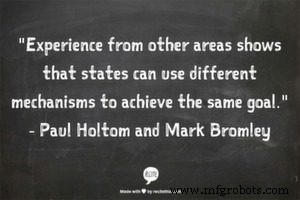
20. “ATT는 조약이 국제 무기 이전을 규제하고 불법 거래를 방지 및 퇴치하는 데 효과적일 수 있도록 당사국이 이행해야 하는 여러 의무를 설명합니다. 접근 방식은 국가마다 다를 수 있으므로 조약 텍스트는 국가가 이러한 의무를 어떻게 이행해야 하는지에 대한 세부 정보를 제공하지 않습니다. 다른 분야의 경험은 국가가 동일한 목표를 달성하기 위해 다른 메커니즘을 사용할 수 있음을 보여줍니다. 예를 들어, 무기 구매자와 판매자를 서로 소개하는 것과 같은 무기 중개 활동을 규제하는 의무는 중개 활동에 대한 라이센스 시스템을 만들거나 그러한 활동을 전면 금지함으로써 달성할 수 있습니다.” – Paul Holtom 및 Mark Bromley, 무기 거래 조약의 다음 단계:조기 발효 보장 , 무기 통제 협회, Twitter:@armscontrolnow
21. “이 삼각형의 세 면 모두가 중요하므로 포괄적인 범위를 가질 수 있습니다. 엄격한 기준을 가질 수 있습니다. 그러나 이러한 것들을 실제로 실제로 작동하게 하는 방법에 대한 강력한 메커니즘, 시스템 및 절차가 없다면 모두 종이에 적힌 단어일 뿐입니다.” – 로이 이스비스터, Saferworld의 소형 무기 및 이전 통제 팀 리더, 무기 거래 조약 이행 웨비나 (트위터:@Saferworld). 이 비디오에서 Isbister는 국가가 데이터 관리 시스템, 항목 목록, 거래, 통제를 시행할 권한과 능력, 지속적인 토론을 위한 공개 보고 시스템 및 포럼이 필요할 것이라고 지적합니다.
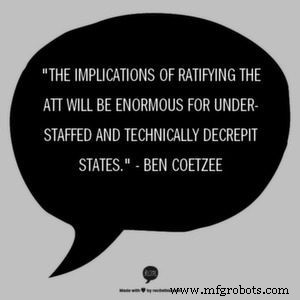
22. “ATT 프레임워크는 총 50개 주에서 비준되거나 가입될 때까지 발효되지 않습니다. 지금까지 세계 3위의 무기 거래국인 독일을 포함해 6개국이 조약을 비준했다. 이 프레임워크의 구현은 불법 무기 거래의 확산을 위한 불법 국경 통과 및 기타 통로를 모니터링하기 위한 기반 시설과 자원이 필요하기 때문에 소규모 개발도상국에 문제가 될 수 있습니다. 남아프리카 공화국 안보연구소(Institute for Security Studies)의 저자 Ben Coetzee는 '무기 거래 조약을 실제로 실행하는 것이 아프리카의 진정한 도전'이라는 기사에서 다음과 같이 지적했습니다. 기술적으로 쇠퇴한 국가.'” – Lia Petridis Maiello, UN-이니셔티브 UNSCAR:소규모 국가가 무기 거래 조약(ATT)을 이행하도록 지원 , 허핑턴 포스트, 트위터 @Lia_P_Maiello
23. “국가가 ATT에 확립된 무기 이전 결정에 대한 공통 표준을 채택하고 성공적으로 구현한다면 인간 안보가 강화될 뿐만 아니라 오늘날 점점 더 세계화되는 세계에 존재하는 다양한 규제 접근 방식이 조화를 이룰 것입니다. 공통 표준을 광범위하게 구현하면 '공정한 경쟁의 장'을 마련하는 데 도움이 될 것입니다. 책임 있는 수출업체가 무책임하게 불안정을 조장하는 것을 보는 것은 책임 있는 수출업체의 이익이 아닙니다. 규제가 덜한 공급업체가 시장에 진입하면 국가와 지역이 불안정해지고 현재의 국제 보안 프레임워크를 준수하는 산업에 부정적인 영향을 미칩니다. 더욱이, 글로벌 방위 산업의 글로벌 공급망에 대한 의존은 큰 기회를 제공하는 반면, 다양한 국가 규제 체제는 산업의 부담을 증가시키고 무기 이전 프로세스를 더 복잡하고 비용이 많이 들게 하여 비즈니스를 복잡하게 만들 수 있습니다." – Rachel Stohl, 초당파적 Stimson Center의 Managing Across Boundaries Initiative, 국제 무기 거래를 위한 글로벌 전략 조정 , 국제 관계 및 보안 네트워크, Twitter:@rachelstohl
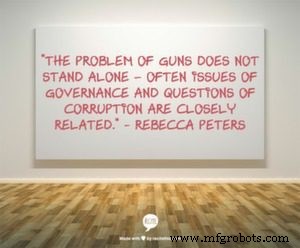
24. “총기 규제법의 집행을 어떻게 보장할 수 있습니까?”라는 질문에 Rebecca Peters는 이렇게 대답합니다. “총기 문제는 혼자만의 문제가 아닙니다. 종종 거버넌스 문제와 부패 문제가 밀접하게 관련되어 있습니다. 무장 폭력이 문제인 많은 국가의 경찰은 종종 총기 규제법을 집행하기 위해 노력하지 않거나 불법 총기 거래에 연루됩니다. 경찰은 또한 무기를 오용하거나 자신의 직위를 남용하는 것으로 알려져 있습니다. 이 모든 것이 시민들의 무장 욕구에 기여합니다. 정부는 그들을 보호하지 못하거나 실제로 적극적으로 공격하고 있습니다.
“또한 그들이 무장하고 있는 방식으로 설계된 정책이 있어야 합니다. 성공적으로 구현할 수 있습니다. 예를 들어 총기법은 자동차와 마찬가지로 모든 무기가 등록되도록 해야 합니다. 많은 법률에서는 총기를 구매한 후에만 총기를 등록하도록 요구하므로 사실상 등록을 선택 사항으로 만듭니다. 일부 국가에서는 판매자가 총기 구매 시 거래를 등록해야 하며 구매자는 등록 절차가 완료될 때까지 총기를 소유할 수 없습니다.
“때때로 법률은 총기의 소유권을 침해하는 방식으로 설계되었습니다. 효율성 – 거래에서 총이 등록되는 시점은 매우 사소해 보일 수 있지만 실제로는 모든 차이를 만듭니다. IANSA는 민간인 총기 소지에 관한 효과적인 법률의 원칙을 개발하여 법률이 시행될 가능성을 최대한 높일 수 있도록 지원합니다. 또한 효과적인 집행은 경찰의 청렴성과 기록 보관 능력을 향상시키는 데 달려 있습니다.” – Rebecca Peters, IANSA 이사, 소형 무기에 관한 국제 행동 네트워크, IRIN 뉴스, 트위터 @irinnews
25. “무기 거래 조약은 회원국이 무기 수출을 모니터링하고 무기가 기존 무기 금수 조치를 넘어서거나 테러를 포함한 인권 침해에 사용되지 않도록 해야 합니다. 회원국은 UN의 지원을 받아 시행 가능하고 표준화된 무기 수입 및 수출 규정(미국에 이미 존재하는 것과 유사)을 시행하고 수출 목적지를 추적하여 최종 무기 수출이 종료되지 않도록 해야 합니다. 잘못된 손에. 이상적으로는 시리아와 같은 곳으로 치명적인 무기의 유입을 제한하는 것을 의미합니다.” – Noah Rayman, The Real News at the UN:U.S. Signs Arms Trade Treaty , TIME, 트위터 @noahrayman
26. “무기 거래 조약(ATT)이 주로 국가 차원에서 시행되고 국제 무기 이전에 대한 결정은 개별 국가에서 이뤄질 것이라는 일반적인 이해가 있습니다. 정부 사이에는 초국가적 기구가 내리는 면허 또는 승인 결정에 대한 욕구가 거의 또는 전혀 없습니다. 따라서 ATT를 완전히 이행하기 위해 모든 국가는 면허/허가 조항, 집행 메커니즘 및 외부 커뮤니케이션 기능을 가능하게 하는 법률, 규정 및 행정 절차 및 능력을 포함하는 재래식 무기의 국제 이전을 통제하기 위한 국가 시스템을 요구할 것입니다. (예를 들어, 산업계에 대한 지원을 허용하는 메커니즘, 국제 무기 이전 활동에 대한 보고서를 생성할 수 있는 능력, 국제 무기 이전 문제에 대한 정보 요청을 발행하고 이에 응답할 수 있는 능력 포함).
" ATT 구현을 지원하고 촉진하기 위해 특히 다음과 같은 국제 메커니즘 및 구조에 대한 규정이 필요합니다. 의미 있는 보고, 정보 공유, 기록 보관 및 투명성 보장; 조약의 적용과 관련된 문제에 대한 당사국 간의 대화를 허용합니다. 당사국 간의 협력과 이행을 위한 적절한 지원의 제공 및 조정을 촉진합니다. 문제 해결, 분쟁 관리 및 지속적인 조약 유지 및 개발을 가능하게 합니다. 어느 한쪽에 채택된 접근 방식이 다른 쪽에도 영향을 미친다는 점에서 이러한 측면 중 많은 부분이 상호 의존적입니다.” – 무기 거래 조약의 이행 프레임워크 , Saferworld, Twitter @Saferworld
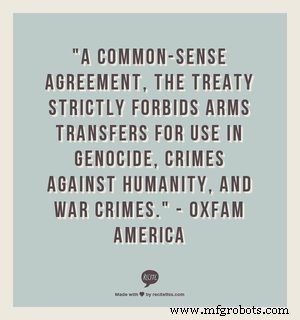
27. 무기 거래 조약이 발효되기 위해서는 최소 50개 국가가 비준해야 합니다. Oxfam America는 무기 거래 조약의 필요성을 설명하는 인포그래픽을 공유하며 “미국 국무장관 John Kerry는 9월 25일 뉴욕에서 무기 거래 조약에 서명합니다.
“세계 최대 무기 수출국인 미국 —최초의 국제 무기 거래 조약에 서명하는 데 100개 이상의 다른 국가와 합류했습니다. 상식적인 합의인 이 조약은 집단 학살, 반인도적 범죄, 전쟁 범죄에 사용하기 위한 무기 이전을 엄격히 금지합니다. 옥스팜은 현재 시리아 내전과 같이 국제 인권 및 인도법을 위반할 주요 위험이 있는 곳에서 무기 이전을 승인하지 않음으로써 조약의 정신에 부응할 것을 미국에 촉구하고 있습니다.
“Oxfam은 또한 새로운 브리핑 페이퍼 '상식으로 생명을 구하는 것:무기 거래 조약에 대한 미국의 지속적인 지원에 대한 사례'에서 중요한 단계를 강력하게 주장하면서 미국 상원에 조약을 신속하게 비준할 것을 촉구했습니다. 50개국이 비준하면 발효된다. 옹호자들은 그것이 2014년 말 이전에 이루어질 것으로 예상합니다. 미국에서 비준하려면 상원의 3분의 2의 동의가 필요합니다.” – Now is the Time for an Arms Trade Treaty , Oxfam America, Twitter:@Oxfam
28. The Arms Trade Treaty has already reached the 50-ratification benchmark, meaning it will go into effect on December 24, 2014. “With state support moving at an unprecedented pace, the Arms Trade Treaty will enter into force on Dec. 24, 2014, only 18 months after it was opened for signature.
“Eight states – Argentina, the Bahamas, Bosnia and Herzegovina, the Czech Republic, Saint Lucia, Portugal, Senegal and Uruguay – ratified the Arms Trade Treaty (ATT) at a special event at the United Nations this past Thursday, Sep. 25, pushing the number of states parties up to 53.
“As per article 22 of the treaty, the ATT comes into force as a part of international law 90 days after the 50th instrument of ratification is deposited.
“According to a statement by the Control Arms coalition, ‘The ATT is one of the fastest arms agreements to move toward entry into force.’” – Joel Jaeger, Arms Trade Treaty Gains Momentum with 50th Ratification , Inter Press Service News Agency, Twitter:@ipsnews
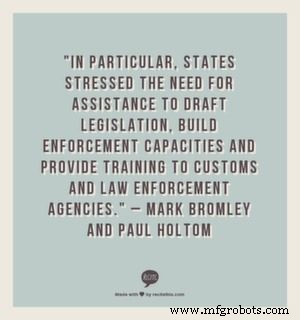
29. The need for more advanced states to assist those without the current frameworks, knowledge, or capacity to implement adequate systems to comply with the Arms Trade Treaty is one that’s been frequently addressed in the media, by analysts, and by organizations with vested interest in the advancement of the Arms Trade Treaty. “The adoption of the Arms Trade Treaty (ATT) in the United Nations General Assembly in April 2013 represented the successful conclusion of years of deliberations and negotiations among UN member states. During the process of negotiating the ATT a large number of states in the Global South stressed the need for the treaty to include provisions for financial, technical and material assistance aimed at helping states to fulfil treaty obligations. In particular, states stressed the need for assistance to draft legislation, build enforcement capacities and provide training to customs and law enforcement agencies. The challenges for states that do not have robust transfer control systems and which have limited capacities to implement the ATT were acknowledged by states in the Global North, which also indicated potential areas where assistance could be provided, such as establishing and strengthening legislative and administrative frameworks, and licensing and enforcement capacities.” – Mark Bromley and Paul Holtom, Arms Trade Treaty Assistance:Identifying a Role for the European Union , EU Non-Proliferation Consortium, Twitter:@SIPRIorg
Data Management, Weapons Tracking, and Reporting
Implementing the Arms Trade Treaty depends substantially on the implementation of consistent, adequate procedures for tracking weapons, reporting, and managing the volume of data required to maintain tighter control over arms trade among states. Some states will require the aid of those with more sophisticated technology in creating appropriate systems and procedures for weapons tracking and reporting.
30. “Article 10 of the ATT draft text allows states the freedom to record and report their arms trade ‘according to their national laws.’ States may ‘exclude commercially sensitive or national security information.’ The current proposal does not consider that the majority of states do not publish national reports on their arms exports and imports, and in several states the national regulations on transparency are minimal, include ineffective requirements, or are purposely weak, thereby reducing record-keeping to an exercise in creative administration. More often, verification mechanisms and law enforcement are underfunded or non-existent. If certain transfers are allowed to go unaccounted for under the guise of commercially sensitive or national security information, the ATT will provide an excuse for governments to hide information on the transfer of arms used in crimes, human rights violations and the excessive accumulation of conventional arms. Only a firm, robust, and mandatory framework for reporting can serve the purpose of a confidence-building ATT; vague, incomplete, unverifiable or ‘censored’ information will not. – Sergio Finardi, Brian Wood, Peter Danssaert, Ken Matthysen, The Arms Trade Treaty:Building a Path to Disarmament , Solutions, TransArmsUSA.org, Twitter:@SolutionsMag
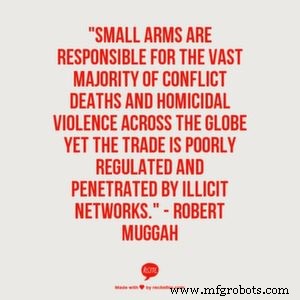
31. The control of global arms trade has been a subject of concern for decades. For instance, even in reports dating back to 1992 the need for a standardized system of tracking and recording data relating to the transfer of arms is presented in a report from the U.S. Congressional Budget Office:“Fundamental to any multilateral agreement to control arms exports would be a system for tracking, recording, and estimating the value of the transfers.” – Limiting conventional arms exports to the Middle East , United States Congressional Budget Office, excerpt via Google Books
32. “In his keynote address to the Stimson Center gathering, Assistant Secretary of State for International Security and Nonproliferation Thomas Countryman said that ‘providing defense equipment to reliable partners in a responsible manner actually enhances security, stability, and promotion of the rule of law.’
“He argued that a successful treaty would compel countries without adequate export controls to improve their national systems, but he cautioned that even a robust treaty would ‘not fundamentally change the nature of international politics nor can it by itself bring an end to the festering international and civil conflicts around the world.’
“Countryman also spoke about U.S. policy on some of the more contentious issues surrounding an ATT, including whether ammunition should be included within its scope. Although the United States already licenses its own import and export of ammunition, he said that the Obama administration had resisted incorporating ammunition because the logistics of monitoring end use through the ATT would be ‘hugely impractical.’”
“‘We have asked our international partners, who proposed this inclusion, to lay out some specific means where such a fungible and consumable commodity could effectively and practically be accounted for,’ said Countryman, adding that he was skeptical that a workable proposal for addressing ammunition through an ATT was at hand. Countryman gave a similar response in his interview with Arms Control Today (see page 21).” – Farrah Zughni, Hurdles for Arms Trade Treaty Underscored , Arms Control Association, Twitter:@armscontrolnow
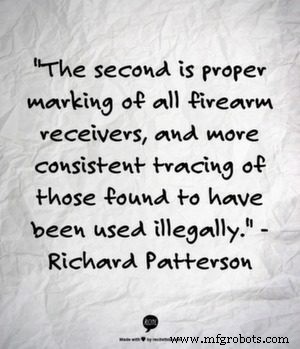
33. “We suggest there are two areas of focus where the United Nations can make a difference. The first is strict management of government stockpiles. The second is proper marking of all firearm receivers, and more consistent tracing of those found to have been used illegally.” – Richard Patterson, Managing Director, Sporting Arms and Ammunition Manufacturers’ Institute, Inc., First Committee of the General Assembly of the United Nations , SAAMI.org
34. “Other States are beginning the process of improving their national control systems to be in compliance with Treaty requirements. The ATT outlines a number of obligations for States Parties to fulfill in order to regulate international arms transfers and prevent and combat illicit trade. The Treaty text does not, however, provide specific details on how States should fulfill these obligations.
“Leading efforts in this endeavor is the Stimson Center and its partner at the University of Coventry, which have developed the Arms Trade Treaty – Baseline Assessment Project (ATT-BAP). The project’s premise is that to successfully implement the ATT, States must first identify their current requirements and needed capacities and resources. Many States have not cataloged their existing systems or identified the ways in which their capabilities can be applied to ATT implementation. The ATT-BAP helps States better understand these factors by providing a baseline assessment survey and ratification checklist to identify any necessary gaps in their current systems in order to effectively implement the Treaty. Upon completion of the ATT-BAP survey and ratification checklist, States will be able to identify what they already do, what they need to do, and what type of assistance they may require to implement the Arms Trade Treaty.
“Data from each completed survey will be used to highlight established best practices and recommend specific legislative and regulatory requirements and approaches needed for States to implement the provisions of the Treaty. This data will also serve as a tool for future ATT implementation projects, as well as those focused on monitoring the impact of and progress resulting from the Treaty’s adoption over time.” – Rachel Stohl, Establishing The Baseline – The Arms Trade Treaty, One Year Later , Stimson.org, Twitter:@rachelstohl
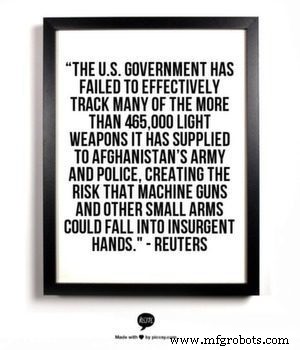
35. The present system in the U.S. for tracking the export of weapons is at times ineffective, according to reports. One July 2014 report appearing in Reuters notes, “The U.S. government has failed to effectively track many of the more than 465,000 light weapons it has supplied to Afghanistan’s army and police, creating the risk that machine guns and other small arms could fall into insurgent hands,” citing a report from the office of the Special Inspector General for Afghanistan Reconstruction (SIGAR), an independent U.S. government watchdog. The report “found that multiple databases maintained by the U.S. government often had missing or duplicate information about weapons provided to Afghan forces.”
The article goes on to cite additional problems beyond the U.S.’s tracking programs. “SIGAR said its investigation into weapons oversight found even more serious problems in the Afghan government’s system for keeping track of small arms once it receives them.” – U.S., Afghanistan fail to track U.S.-supplied small arms:watchdog , Reuters, Twitter:@ReutersWorld
36. “A global system for tracking illicit arms and ammunition is central to improving accountability in the international arms trade and preventing arms getting into the wrong hands. The United Nations negotiations to establish international Marking and Tracing controls present states with an historic opportunity to take a tough stance against the worldwide proliferation of illicit arms and the use of arms for violations of human rights and international humanitarian law and to make real progress.” – Marking and Tracing Arms and Ammunition:a central piece of the arms control puzzle, Control Arms , appearing on Essex.ac.uk, Twitter:@Uni_of_Essex
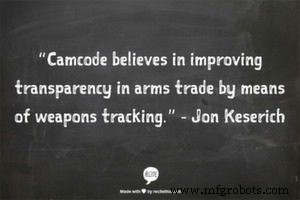
37. “Camcode believes in improving transparency in arms trade by means of weapons tracking,” said Jon Keserich, Managing Director. “What began as a program to help organizations identify, track and control property has now evolved into a mission to help defense organizations and nation states prevent illicit trade of weapons used in civil wars, terrorism, organized crime, gang warfare and other conflicts.” – Jon Keserich, Camcode Global, as quoted in a press release appearing on Benzinga, Twitter:@Camcode
38. “The tracing of illicit firearms is crucial component of the international strategy and framework to combat the illicit trade in small arms and light weapons in all its aspects.” – Interpol, Twitter:@INTERPOL_HQ

39. On the Mapping Arms Data project:“Drawing from existing data sources, the projectMAD website tracks the global trade in small arms, light weapons, and ammunition. Small arms are responsible for the vast majority of conflict deaths and homicidal violence across the globe yet the trade is poorly regulated and penetrated by illicit networks.
“The MAD project increases transparency and promotes accountability in the global trade of small arms and ammunition in order to understand how they threaten security and development throughout the world.” – Robert Muggah, the Igarapé Institute, Peace Research Institute Oslo (PRIO), appearing on MultipleJournalism.org
40. In a 2013 article discussing the challenges faced in controlling crime, particularly due to the lack of tracking mechanisms currently in place, Bloomberg reports, “Without a computer database, ATF traces a gun by contacting the manufacturer to identify the distributor, who will know the dealer. One of those three sources typically will be out of business, which forces ATF to sift through 445 million snapshot images of sales records, said Ginger Colbrun, a spokeswoman.” – Michael C. Bender, Gun Lobby Helps Block Data Collection by Crimefighters , Bloomberg, Twitter:@BloombergNews
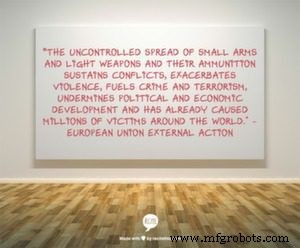
41. “The uncontrolled spread of small arms and light weapons and their ammunition sustains conflicts, exacerbates violence, fuels crime and terrorism, undermines political and economic development and has already caused millions of victims around the world.
“As part of its efforts to tackle this issue, the EU funds the iTrace project (Council Decision 2013/698/CFSP). It provides policy makers with precise, verified information on transfers of diverted small arms and light weapons (SALW), larger conventional weapons and ammunition. The project, which is implemented by Conflict Armament Research, combines an extensive programme of field investigations in conflict-affected countries with a powerful public access weapons tracking database.” – EU supports weapons tracking system iTrace , European Union External Action, Twitter:@eu_eeas
42. While the Arms Trade Treaty focuses on international imports and exports, there’s huge potential in gathering data on even domestic weapons, such as those used by police forces. In an article on Forbes, Aaron Tilley talks Internet-connected guns for police and how it may be the next step in new technology for police departments:“’There’s an overall transition with more sensors out there in the world to invade our privacy,’ said Jay Stanley, a senior policy analyst at ACLU’s Speech, Privacy and Technology Project, in a phone interview. ‘Using sensors to increase transparency with police officers is maybe a silver lining to all of this. … When the police shoot a gun, it’s a matter of public importance.’
“Like dash cams or body cameras on officers, the Yardarm sensor could be used to collect more data with what’s happening while officers are on duty. It could help reconstruct what actually happened after an incident.” – Aaron Tilley, Internet-Connected Guns Are The Next Step For Data-Hungry Police , Forbes, Twitter:@aatilley
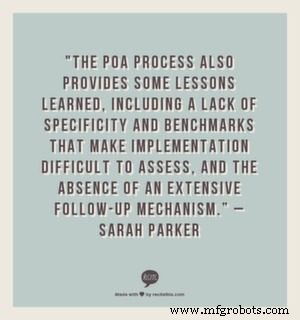
43. There’s also talk about how the ATT impacts or overlaps with the UN Programme of Action to Prevent, Combat and Eradicate the Illicit Trade in Small Arms and Light Weapons in All Its Aspects (PoA). “The simple truth is that the practical and political impact of the ATT deliberations on the outcome of the 2nd Review Conference and the PoA process as a whole cannot be accurately predicted. What is clear, however, is that while the ATT has the potential to enhance and supplement the PoA provisions relating to international transfers, it cannot and should not be viewed as replacing the PoA in its entirety. International transfer controls are but one aspect of the PoA amid a broad range of arms control measures to which UN member states have committed themselves. The PoA offers a platform in terms of existing small arms control measures that could and should be built on in an ATT, and care should be taken to avoid contradiction and ensure complementarity between the two instruments. The PoA process also provides some lessons learned, including a lack of specificity and benchmarks that make implementation difficult to assess, and the absence of an extensive follow-up mechanism.” – Sarah Parker, An Arms Trade Treaty:Will It Support or Supplant the PoA? , SmallArmsSurvey.org Research Notes, Twitter:@SmallArmsSurvey
44. While the Arms Trade Treaty has been ratified by more than the 50 states required to facilitate its implementation, there’s still much work to be done. Namely, states must determine universal processes and systems for efficiently tracking the weapons imported and exported by individual states. The data gathered through this process will drive further decision-making. “In order for the ATT to fulfil its potential of bringing greater responsibility and transparency to the international arms trade, states parties and other ATT stakeholders will need to give thought to the mechanisms needed to enable effective treaty implementation and to facilitate universalization. While the treaty lays out a basic framework for implementation, many key decisions can only be taken after it enters into force.” – Sibylle Bauer, Paul Beijer, and Mark Bromley, The Arms Trade Treaty:Challenges for the First Conference of States Parties , SIPRI Insights on Peace and Security, Twitter:@SIPRIorg
On Whether the Arms Trade Treaty Infringes on Second Amendment Rights
There is much discussion among advocates for Second Amendment rights, with concerns being raised that the Arms Trade Treaty infringes on Americans’ right to bear arms. However, many experts have clarified the Arms Trade Treaty, noting that the ATT does not impact the trade or sale of arms within the United States; rather, the importing and exporting of weapons between the United States and other states around the world.

45. “I want to be clear both about what this treaty is, but I also want to be clear about what it isn’t. This is about keeping weapons out of the hands of terrorists and rogue actors. This is about reducing the risk of international transfers of conventional arms that will be used to carry out the world’s worst crimes. This is about keeping Americans safe and keeping America strong. And this is about promoting international peace and global security. And this is about advancing important humanitarian goals.
“I also want to be clear about what this treaty is not about. This treaty will not diminish anyone’s freedom. In fact, the treaty recognizes the freedom of both individuals and states to obtain, possess, and use arms for legitimate purposes. Make no mistake, we would never think about supporting a treaty that is inconsistent with the rights of Americans, the rights of American citizens, to be able to exercise their guaranteed rights under our constitution. This treaty reaffirms the sovereign right of each country to decide for itself, consistent with its own constitutional and legal requirements, how to deal with the conventional arms that are exclusively used within its borders.” – Secretary John Kerry, Remarks at the Arms Trade Treaty Signing Ceremony , as quoted by the U.S. Department of State, Twitter:@StateDept
46. “The treaty begins with a preamble that ‘reaffirms the sovereign right of any State to regulate and control conventional arms exclusively within its territory, pursuant to its own legal or constitutional system.’ This statement isn’t buried in some footnote; it’s found at the very beginning of the text. Now please correct me if I’m wrong, but doesn’t this mean that our government, and not the United Nations, gets to figure out how guns will be handled within the United States?
And what about the question of end users, because here’s where the NRA believes there lurks an attempt to create not just a national, but an international registry of all guns. I quote again from the treaty text:‘Each State Party shall maintain national records, pursuant to its national laws and regulations, of its issuance of export authorizations or its actual exports of the conventional arms…’ Now note what it says about imports:‘Each State Party is encouraged to include in those records:the quantity, value, model/type, authorized international transfers of conventional arms actually transferred, details of exporting State(s), importing State(s), transit and trans-shipment State(s), and end users, as appropriate.’
This is in fact no different than what U.S. exporters and importers must now do to comply with State Department and ATF regulations on export and import of small arms. These regulations are required to be followed by anyone who imports guns into the United States. But the operative word in the Treaty is encouraged; not required as in the case of U.S. law. Signatories to this treaty are not bound by any requirements to either compile lists of import end-users (which U.S. importers already compile) or deliver such lists to any international body. The only required record-keeping involves the destination of exports, and correct me if I’m wrong, but only American citizens possess Second Amendment guarantees.” – Mike Weisser, What Does The Arms Trade Treaty Really Say? , Huffington Post, Twitter:@HuffingtonPost

47. While many critics of the ATT express concern that the Treaty is merely the first step in a larger gun-grabbing attempt, proponents of the ATT continue to emphasize the fact that the Treaty focuses on international importing and exporting of weapons that are likely to be used to infringe upon human rights. “Rasha Abul-Rahim of Amnesty International thinks that though the U.S. has a large pro-gun population, it has taken steps to further regulate conventional arms sales.
“’Basically the directive pledges not to export arms where there’s a likelihood that the weapons transferred will be likely to be used for genocide or other atrocities, or will be used to violate human rights law or international humanitarian law,’ Abul-Rahim told german publication Deutsch Welle on Thursday. ‘This is a positive development and an indication that the U.S. could ratify in the future.’” – Rasha Abul-Rahim, Amnesty International, as quoted in U.S. advisory council responds to recent ratification of arms trade treaty , Guns.com, Twitter:@Guns_com
48. PolitiFact.com did some investigating into claims by the NRA and political leaders regarding the potential of the ATT to infringe upon Americans’ Second Amendment rights. “The National Rifle Association issued a statement after Secretary of State John Kerry signed the treaty saying it ‘threatens individual firearm ownership and an invasive registration scheme.’ Despite all signs to the contrary, the NRA and other groups opposed to the treaty insist it will create a slippery slope leading to a national gun registry.
“However, previous PolitiFact checks don’t back that up. PolitiFact Georgia, in an Aug. 12, 2012 story, interviewed legal experts and concluded, ‘…even in the unlikely event that the U.N. creates a treaty that provides for domestic registries and the U.S. Senate ratifies it, it would not ‘almost certainly force’ the U.S. to create one,’ as a Georgia congressman had alleged.” PolitiFact.com sums up this analysis with, “The claim is all flash and no powder. We rate it False.” – Dana Tims, Will the U.N. Arms Trade Treaty infringe on our right to keep and bear arms? , PolitiFact.com, Twitter:@PolitiFact

49. “The Arms Trade Treaty is consistent with America’s national security interests, foreign policy goals, business interests and moral traditions, which is why United States negotiators worked so hard to create it.
“So what’s behind the foreboding whispers? Some truly cynical domestic politics, it would appear.
“Those opposed to the accord have misrepresented what it does, suggesting that it would somehow infringe on American gun owners’ rights. It would do nothing of the kind.” – Rachel Stohl, Tell the Truth About the Arms Treaty , The New York Times, Twitter:@rachelstohl
50. Some political leaders, such as Texas Attorney General Greg Abbott, have recognized that the Arms Trade Treaty actually does not contain language that infringes on Second Amendment Rights, but continue to cite concerns that the ATT merely opens the door for future regulations that could, in fact, do so. But the American Bar Association squashes these fears:“Counter to Abbott’s claim that the United Nations would be able to interpret the treaty in a way that would violate individual ownership rights, the American Bar Association has concluded that Americans needn’t fear such an outcome. As the ABA points out in their white paper, import restrictions on firearms have been ruled constitutionally valid. At present, the Bureau of Alcohol, Tobacco and Firearms regulates and tracks the import of firearms into the United States, leaving no need for further domestic legislation regarding the ATT’s implementation.
“Exports of firearms, the ABA also notes, are not protected under the Second Amendment. Further, thanks to the efforts of countries like the United States, the ATT is not as strong as some advocates would prefer. Instead, the treaty is written to only affect the transfer of arms between states, not individuals, and only bars that transfer in the event of massive human rights violations on the level of crimes against humanity. The ABA does agree with Abbott, though, that any parts of the Arms Trade Treaty that would violate the Second Amendment would be rendered void.” – Hayes Brown, Texas Attorney General Admits Arms Treaty Doesn’t Violate Second Amendment , ThinkProgress.org, Twitter:@thinkprogress
Asset Tracking Solutions from Camcode:
산업기술
Reuters의 보도에 따르면 피츠버그에 자신의 생각으로 직접 제어되는 로봇 팔을 사용하여 물건을 옮기고 스스로 먹을 수 있는 여성이 있다고 합니다. 이 기계 팔은 뇌-기계 인터페이스에 대한 연구의 일부입니다. 과학자들은 이 인터페이스가 신경 손상을 우회하고 마비된 근육이 다시 작동하도록 도울 수 있다고 믿습니다. 이 의료용 로봇 팔은 미래에 많은 마비 환자와 절단 환자를 도울 수 있는 돌파구이지만 배후에서 수년 동안 인간을 돕고 있는 다른 로봇 팔이 있습니다. 이들은 다관절 산업용 로봇입니다. 다관절 로봇은 일반적으로 전기
산업용 로봇 팔이 사용되는 방식에 대해 생각할 때 육류 산업이 떠오르지 않을 수 있습니다. 대부분의 사람들은 자동차 또는 전자 제품 제조를 먼저 생각합니다. 그러나 육류 산업은 현재 산업용 로봇 팔을 사용하고 있으며 가까운 장래에 더 많은 자동화를 통합할 계획입니다. 이러한 산업용 로봇 팔의 대부분은 육류 가공 공장에 있으며 동물 사체를 조각내는 데 사용됩니다. 예를 들어 Jarvis는 발굽 절단 로봇입니다. 이 Motoman 50kg 로봇 암에는 비전 시스템과 커팅 블레이드가 있어 가공을 위해 들어오는 쇠고기 사체의 발굽을 자동